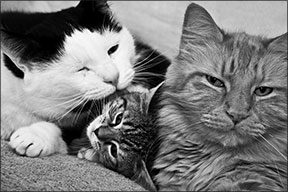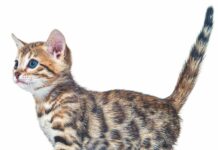Threatening Environments Can Activate Their Stress Response
We may think our cats have it easy, being fed and loved while living safely indoors, but nutritionist Tony Buffington, DVM, Ph.D., at Ohio State University College of Veterinary Medicine says cats can have a different perspective:
“What the cat sees is, ‘Well, I’m confined to this house, I have no choice what to eat or drink, I’ve only got one tiny place that I can eliminate in, and I just have to hope that somehow magically it gets clean because I can’t do it.’”
Natural behaviors like climbing and scratching can lead to cats being punished or even relinquished, Dr. Buffingon says. “If they’re living in a threatening enough environment, their stress response system, their sympathetic nervous system, their hormonal system and their immune system can all be activated searching for the threat.”
If the threat is ongoing, the resulting stress can cause illness, such as lower urinary tract disease, Dr. Buffington says. “It turns out that the disease in many cases is a consequence of this chronic activation of the stress response system.”
He offers advice on reducing stress and enriching cats’ lives in a podcast from the American Association of Veterinary Medicine at www.avmamedia.org/display.asp?sid=556&NAME=Creating_a_cat-friendly_home. It’s also available on iTunes via AVMA’s Animal Tracks channel, a free series on health and safety.
Stress seems to play a role in a urinary disease affecting humans and cats. The Feline Health Center at Cornell notes similarities between feline idiopathic cystitis (FIC) — the most common diagnosis in cats with lower urinary tract signs — and a bladder disorder affecting humans called interstitial cystitis. (For more information, see Health Resources at www.vet.cornell.edu/fhc.)
“In humans, a psychologically stressful event often precedes the onset of lower urinary tract discomfort due to interstitial cystitis, and stress also seems to be an important factor in the development of FIC in cats,” the center says.


It describes stressors as changes in the environment, food schedule and number of animals in the household, and recommends that cats have a safe, clean area in which to eliminate and opportunities to express natural predatory behavior, including climbing posts and toys that can be chased and caught.
More on Urinary Disease
Urinary tract diseases topped the list of the most common conditions in cats in medical claims to Veterinary Pet Insurance last year. The company sorted its database of more than 500,000 insured pets to find 4,600 claims for the ailment at an average cost of $422 for a veterinary visit.
These were the top conditions in cats:
1. Bladder or urinary tract disease
2. Periodontitis/dental disease
3. Chronic kidney disease
4. Hyperthyroidism
5. Upset stomach/vomiting
6. Diabetes
7. Intestinal upset/diarrhea
8. Lymphoma
9. Upper respiratory infection
10. Skin allergies
The most expensive treatment was for lymphoma with an average cost of $2,004. “Many of the conditions on our Top 10 list each year can be stopped early or successfully managed in partnership with a veterinarian,” says Carol McConnell, DVM, MBA, VPI’s vice president and chief veterinary medical officer. ❖



